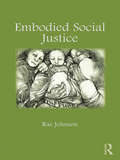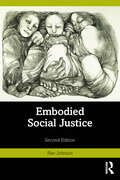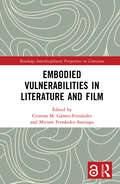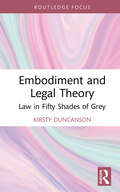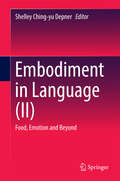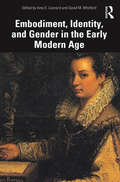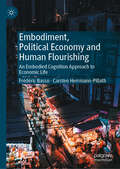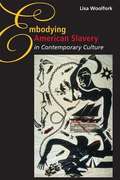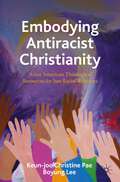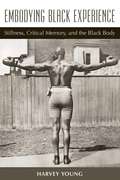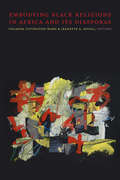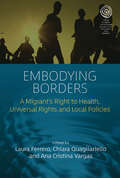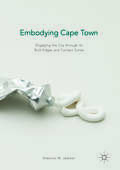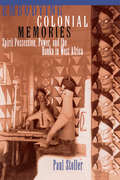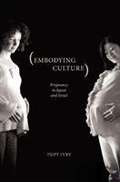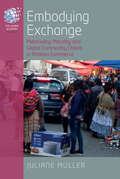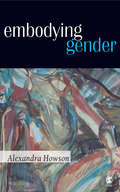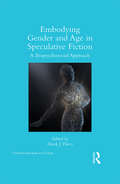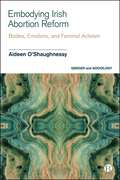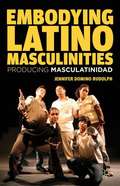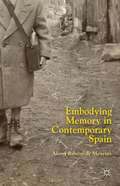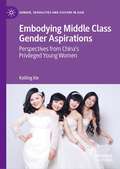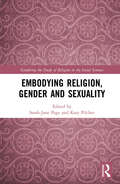- Table View
- List View
Embodied Social Justice
by Rae JohnsonEmbodied Social Justice introduces a body-centered approach to working with oppression, designed for social workers, counselors, educators, and other human service professionals. Grounded in current research, this integrative approach to social justice works directly with the implicit knowledge of our bodies to address imbalances in social power. Consisting of a conceptual framework, case examples, and a model of practice, Embodied Social Justice integrates key findings from education, psychology, traumatology, and somatic studies while addressing critical gaps in how these fields have understood and responded to everyday issues of social justice.
Embodied Social Justice
by Rae JohnsonEmbodied Social Justice introduces an embodied approach to working with oppression. Grounded in current research, the book integrates key findings from education, psychology, sociology, and somatic studies while addressing critical gaps in how these fields have addressed pervasive patterns of social injustice. At the heart of the book, a series of embodied narratives bring to life everyday experiences of oppression through evocative descriptions of how power implicitly shapes body image, interpersonal space, eye contact, gestures, and the use of touch. This second edition includes two new "body stories" from research participants living and working in the global South. Supplemental guidelines for practice, updated references, and new community resources have also been added. Designed for social workers, counselors, educators, and other human service professionals working with members of disenfranchised and marginalized communities, Embodied Social Justice offers a conceptual framework and model of practice to assist in identifying, unpacking, and transforming embodied experiences of oppression from the inside out.
Embodied VulnerAbilities in Literature and Film (Routledge Interdisciplinary Perspectives on Literature)
by Miriam Fernández-Santiago Gámez-Fernández, Cristina MEmbodied VulnerAbilities in Literature and Film includes a collection of essays exploring the ways in which recent literary and filmic representations of vulnerability depict embodied forms of vulnerability across languages, media, genres, countries, and traditions in the late 20th and early 21st centuries. The volume gathers 12 chapters penned by scholars from Japan, the USA, Canada, and Spain which look into the representation of vulnerability in human bodies and subjectivities. Not only is the array of genres covered in this volume significant— from narrative, drama, poetry, (auto)documentary, or film— in fiction and nonfiction, but also the varied cultural and linguistic coordinates of the literary and filmic texts scrutinized—from the USA, Canada, Spain, France, the Middle East, to Japan. Readers who decide to open the cover of this volume will benefit from becoming familiar with a relatively old topic— that of vulnerability— from a new perspective, so that they can consider the great potential of this critical concept anew.
Embodiment and Legal Theory: Law in Fifty Shades of Grey
by Kirsty DuncansonThis book addresses the importance of the body in legal theory, through an analysis of the film Fifty Shades of Grey.As physical beings, we experience law in sensations of outrage when it is applied unethically, righteousness when it finds justice, and joy when it establishes partnerships in marriage. Our bodies feel and know law. In Embodiment and Legal Theory, it is argued that our bodies also theorise law. It is proposed that our bodies are involved in comprehending, negotiating, and reimagining the legal concepts that shape our lives. As a medium designed to engage us by stimulating our bodily reactions of tears, laughter, shock, and titillation, cinema provides an ideal site for exploring how bodies participate in legal arguments and the construction of legal meaning. For this reason, through a deep analysis of the film Fifty Shades of Grey (2015), this book presents a theory of embodied jurisprudence.At the intersection of legal theory and film studies, this book will appeal to students and scholars in both these areas, as well as in criminology and cultural studies.
Embodiment and Mechanisation: Reciprocal Understandings of Body and Machine from the Renaissance to the Present
by Daniel BlackDrawing on philosophical, neurological and cultural answers to the question of what constitutes a body, this book explores the interaction between mechanistic beliefs about human bodies and the successive technologies that have established and illustrated these beliefs. At the same time, it draws upon newer perspectives on technology and embodied human thought in order to highlight the limitations and inadequacies of such beliefs and suggest alternative perspectives. In so doing, it provides a position from which widely held assumptions about our relationship with technology can be understood and questioned, by both showing how these presuppositions have emerged and developed, and examining the extent to which they are dependent upon our grasp of specific technologies. Illustrated with examples from the Renaissance and Enlightenment periods, as well as the industrial age and the recent eras of informatics, gene science and nanotechnology, Embodiment and Mechanisation highlights the ways in which technological changes have led to shifts in the definition of machine and body, investigating their shared underlying belief that all matter can be reduced to a common substance. From clockwork and cadavers to engines and energy, this volume reveals our long-standing fascination with and enduring commitment to the idea that bodies are machines and that machines are in some sense bodies. As such, it will appeal to scholars across the humanities and social sciences with interests in the sociology of science and technology, embodiment, cultural studies and the history of ideas.
Embodiment in Language (II)
by Shelley Ching-yu DepnerThis book provides useful strategies for language learning, researching and the understanding of social factors that influence human behavior. It offers an account of how we use human, animal and plant fixed expressions every day and the cultural aspects hidden behind them. These fixed expressions include various linguistic vehicles, such as fruit, jokes and taboos that are related to speakers' use in the real world. The linguistic research in Mandarin Chinese, Hakka, German and English furthers our understanding of the cultural value and model of cognition embedded in life-form embodiment languages.
Embodiment, Identity, and Gender in the Early Modern Age
by David M. Whitford Amy E. LeonardEmbracing a multiconfessional and transnational approach that stretches from central Europe, to Scotland and England, from Iberia to Africa and Asia, this volume explores the lives, work, and experiences of women and men during the tumultuous fifteenth to seventeenth centuries. The authors, all leading experts in their fields, utilize a broad range of methodologies from cultural history to women’s history, from masculinity studies to digital mapping, to explore the dynamics and power of constructed gender roles. Ranging from intellectual representations of virginity to the plight of refugees, from the sea journeys of Jesuit missionaries to the impact of Transatlantic economies on women’s work, from nuns discovering new ways to tolerate different religious expressions to bleeding corpses used in criminal trials, these essays address the wide diversity and historical complexity of identity, gender, and the body in the early modern age. With its diversity of topics, fields, and interests of its authors, this volume is a valuable source for students and scholars of the history of women, gender, and sexuality as well as social and cultural history in the early modern world.
Embodiment, Political Economy and Human Flourishing: An Embodied Cognition Approach to Economic Life
by Carsten Herrmann-Pillath Frédéric BassoThis book presents embodied economics as a foundational alternative to behavioral economics and other projects integrating economics and psychology inspired by the computational paradigm. The 20th century witnessed the disembodiment of economic models through the intensification of mathematization and formal abstraction in economics. Even proponents of an embodied approach to cognition, such as Hayek, paradoxically championed the abstract market order as a disembodied superhuman intelligence. In the wake of groundbreaking perspectives in cognitive and social sciences, which have helped to rethink the fundamental building blocks of economics, agency and institutions, this title takes a radical turn towards embodiment. Reinstating economics as political economy, embodied economics motivates a critique of capitalism based on the analysis of disembodiment through abstraction and reactivates key critical insights into the anthropology put forward by the young Marx about contemporary economics and its conceptualizations of money, property, and labor. Based on this analysis, the authors envision a concrete utopia for an economic order centered on human dignity and care for life on Earth. This book contributes to recent discussions about behavioral, experimental and neuroeconomics and addresses a transdisciplinary audience in the social and behavioral sciences, philosophy, and the humanities.
Embodying American Slavery in Contemporary Culture
by Lisa WoolforkThis study explores contemporary novels, films, performances, and reenactments that depict American slavery and its traumatic effects by invoking a time-travel paradigm to produce a representational strategy of "bodily epistemology." Disrupting the prevailing view of traumatic knowledge that claims that traumatic events are irretrievable and accessible only through oblique reference, these novels and films circumvent the notion of indirect reference by depicting a replaying of the past, forcing present-day protagonists to witness and participate in traumatic histories that for them are neither dead nor past. Lisa Woolfork cogently analyzes how these works deploy a representational strategy that challenges the divide between past and present, imparting to their recreations of American slavery a physical and emotional energy to counter America's apathetic or amnesiac attitude about the trauma of the slave past.
Embodying Antiracist Christianity: Asian American Theological Resources for Just Racial Relations
by Boyung Lee Keun-joo Christine PaeAt a moment of notably rising levels of anti-Asian hate, this book offers antiracist resources informed by Asian/North American feminist theology and biblical scholarship. Although there exist scholarly books and articles on Asian American theology (broadly defined) have proliferated in response to the current ethical, political, and cultural environment have been prolific, there have been few concerted efforts to interrogate or dismantle anti-Asian racism inseparable from anti-black racism, and white settler colonialism that have often undermined the communal spirit and livelihood of Christian churches in the current political climate. In the current political climate, COVID-related anti-Asian hate and racial conflict, which all intersect with gender and sexuality-based violence, require theological, moral, and political inquiries. Hence, this book notes the current paucity of work with critical discussions on the multiple facets of racism from Asian American feminist theological perspectives. Contributors deepen the inter/transdisciplinary approaches concerning how to dismantle racist theological teachings, biblical interpretations, liturgical presentations, and the Christian church’s leadership structure.
Embodying Black Experience: Stillness, Critical Memory, and the Black Body
by Harvey Young"Young's linkage between critical race theory, historical inquiry, and performance studies is a necessary intersection. Innovative, creative, and provocative. " ---Davarian Baldwin, Paul E. Raether Distinguished Professor of American Studies, Trinity College In 1901, George Ward, a lynching victim, was attacked, murdered, and dismembered by a mob of white men, women, and children. As his lifeless body burned in a fire, enterprising white youth cut off his toes and, later, his fingers and sold them as souvenirs. InEmbodying Black Experience, Harvey Young masterfully blends biography, archival history, performance theory, and phenomenology to relay the experiences of black men and women who, like Ward, were profoundly affected by the spectacular intrusion of racial violence within their lives. Looking back over the past two hundred years---from the exhibition of boxer Tom Molineaux and Saartjie Baartman (the "Hottentot Venus") in 1810 to twenty-first century experiences of racial profiling and incarceration---Young chronicles a set of black experiences, or what he calls, "phenomenal blackness," that developed not only from the experience of abuse but also from a variety of performances of resistance that were devised to respond to the highly predictable and anticipated arrival of racial violence within a person's lifetime. Embodying Black Experiencepinpoints selected artistic and athletic performances---photography, boxing, theater/performance art, and museum display---as portals through which to gain access to the lived experiences of a variety of individuals. The photographs of Joseph Zealy, Richard Roberts, and Walker Evans; the boxing performances of Jack Johnson, Joe Louis, and Muhammad Ali; the plays of Suzan-Lori Parks, Robbie McCauley, and Dael Orlandersmith; and the tragic performances of Bootjack McDaniels and James Cameron offer insight into the lives of black folk across two centuries and the ways that black artists, performers, and athletes challenged the racist (and racializing) assumptions of the societies in which they lived. Blending humanistic and social science perspectives,Embodying Black Experienceexplains the ways in which societal ideas of "the black body," an imagined myth of blackness, get projected across the bodies of actual black folk and, in turn, render them targets of abuse. However, the emphasis on the performances of select artists and athletes also spotlights moments of resistance and, indeed, strength within these most harrowing settings. Harvey Young is Associate Professor of Theatre, Performance Studies, and Radio/Television/Film at Northwestern University. A volume in the series Theater: Theory/Text/Performance
Embodying Black Religions in Africa and Its Diasporas (Religious Cultures of African and African Diaspora People)
by Yolanda Covington-Ward and Jeanette S. JouiliThe contributors to Embodying Black Religions in Africa and Its Diasporas investigate the complex intersections between the body, religious expression, and the construction and transformation of social relationships and political and economic power. Among other topics, the essays examine the dynamics of religious and racial identity among Brazilian Neo-Pentecostals; the significance of cloth coverings in Islamic practice in northern Nigeria; the ethics of socially engaged hip hop lyrics by Black Muslim artists in Britain; ritual dance performances among Mama Tchamba devotees in Togo; and how Ifá practitioners from Mexico, Colombia, Venezuela, Trinidad, and the United States join together in a shared spiritual ethnicity. From possession and spirit-induced trembling to dance, the contributors outline how embodied religious practices are central to expressing and shaping interiority and spiritual lives, national and ethnic belonging, ways of knowing and techniques of healing, and sexual and gender politics. In this way, the body is a crucial site of religiously motivated social action for people of African descent.Contributors. Rachel Cantave, Youssef Carter, N. Fadeke Castor, Yolanda Covington-Ward, Casey Golomski, Elyan Jeanine Hill, Nathanael J. Homewood, Jeanette S. Jouili, Bertin M. Louis Jr., Camee Maddox-Wingfield, Aaron Montoya, Jacob K. Olupona, Elisha P. Renne
Embodying Borders: A Migrant’s Right to Health, Universal Rights and Local Policies (EASA Series #41)
by Laura Ferrero, Chiara Quagliariello Ana Cristina VargasBased on extensive field research, the essays in this volume illuminate the experiences of migrants from their own point of view, providing a critical understanding of the complex social reality in which each experience is grounded. Access to medical care for migrants is a fundamental right which is often ignored. The book provides a critical understanding of the social reality in which social inequalities are grounded and offers the opportunity to show that right to health does not correspond uniquely with access to healthcare.
Embodying Borders: A Migrant’s Right to Health, Universal Rights and Local Policies (EASA Series #41)
by Laura Ferrero, Chiara Quagliariello Ana Cristina VargasBased on extensive field research, the essays in this volume illuminate the experiences of migrants from their own point of view, providing a critical understanding of the complex social reality in which each experience is grounded. Access to medical care for migrants is a fundamental right which is often ignored. The book provides a critical understanding of the social reality in which social inequalities are grounded and offers the opportunity to show that right to health does not correspond uniquely with access to healthcare.
Embodying Cape Town
by Shannon M. JacksonThis book examines the reciprocity that exists between the body and the urban built environment. It will draw on archival and ethnographic research as well as an interdisciplinary literature on cultural materialism, semiotics, and aesthetics to challenge dualist interpretations of four different points of historical-material contact in Cape Town, South Africa. Each chapter attends to different groups, social practices, and historical periods, but all share the fundamental questions: how does material culture reflect the way social agents make meaning through bodily contact with urban built form, and how does such meaning challenge the ways bodies are objectified? Further, how can we make sense of the historical processes embedded in the objectification of bodies without treating the social and the material, the mental and the physical as separate realities?
Embodying Colonial Memories: Spirit Possession, Power, and the Hauka in West Africa
by Paul StollerA study of the West African Hauka - spirits that grotesquely mimic and mock "Europeans" of the colonial epoch. The author considers spirit possession as a set of embodied practices with serious social and cultural consequences. Embodying Colonial Memories is the first in-depth study of the West African Hauka, spirits in the body of (human) mediums which mimic and mock Europeans of the colonial epoch. Paul Stoller, who was initiated into a spirit possession troupe, recounts an insider's tale of the Hauka with respect and "brotherly" deference. He combines narrative description, historical analysis, and reflections on the importance of embodiment and mimesis to social theory, with particular reference to the Songhay peoples of the Republic of Niger.
Embodying Culture: Pregnancy In Japan And Israel
by Tsipy IvryEmbodying Culture is an ethnographically grounded exploration of pregnancy in two different cultures--Japan and Israel--both of which medicalize pregnancy. Tsipy Ivry focuses on "low-risk" or "normal" pregnancies, using cultural comparison to explore the complex relations among ethnic ideas about procreation, local reproductive politics, medical models of pregnancy care, and local modes of maternal agency. The ethnography pieces together the voices of pregnant Japanese and Israeli women, their doctors, their partners, the literature they read, and depicts various clinical encounters such as ultrasound scans, explanatory classes for amniocentesis, birthing classes, and special pregnancy events. The emergent pictures suggest that athough experiences of pregnancy in Japan and Israel differ, pregnancy in both cultures is an energy-consuming project of meaning-making-- suggesting that the sense of biomedical technologies are not only in the technologies themselves but are assigned by those who practice and experience them.
Embodying Exchange: Materiality, Morality and Global Commodity Chains in Andean Commerce (The Human Economy #11)
by Juliane MüllerAddressing the infrastructural, legal and moral complexities in contemporary world trade, this book uses an ethnographic analysis of the interface of multinational brand manufacturers and popular traders in the Bolivian Andes. It offers a situated account of traders’ understanding of regulatory principles, and traces commercial dynamics beyond the limits of what we define as economic. It aims to humanize our understanding of the economy by grounding it in everyday life and morality.
Embodying Gender
by Dr Alexandra HowsonEmbodying Gender provides students and academics with a critical overview of body concepts in both sociology and in feminism. Previously, sociologists have attempted to gender the body and feminists have attempted to embody gender but Alexandra Howson's accessible new text draws these two literatures together, pointing to ways of integrating feminist perspectives on the body into sociological theory. Surveying all the key concepts in the field, this book introduces us to an extensive range of 'narratives of embodiment' and presents a full analysis of the most important texts in new feminist theories of the body. Key questions covered include: o What can sociology say about the body? o What impact has the body made on sociology? o What conceptual frameworks are used to address the body? How do these relate to issues of gender and embodied experience? o How do feminist conceptual tools sit within sociological analysis? Written in a clear, accessible style, Embodying Gender is an invaluable text for undergraduate students, postgraduates and academics in the fields of women's and gender studies and sociology, and is particularly relevant to those specialising in sociology of the body, feminist theory and social theory.
Embodying Gender and Age in Speculative Fiction: A Biopsychosocial Approach (Children's Literature and Culture)
by Derek J. ThiessFollowing scholarship on gender in science fiction, this book explores the limits of considering age as a social construction, positing that an acknowledgement of aged bodies necessarily changes the way we read both age and science fiction. The volume employs contemporary clinical psychology, the biopsychosocial model, to demonstrate that age is an important and neglected topic relevant to the study of speculative fiction. While gender offers a vocabulary, the biopsychosocial approach provides a method to consider age (and gender) as an embodied synthesis of physicality, psychology, and social environment. This respected model of clinical psychology allows a unique and innovative lens through which to read age and the body in literature. Thiess offers readings of established sf classics including Octavia Butler’s Parable series; Orson Scott Card’s Ender’s Game; and cyberpunk authors such as Bruce Sterling, Pat Cadigan, and Neal Stephenson, also exploring more mainstream speculative works including Stephanie Meyer’s Twilight series and Joss Whedon’s Firefly/Serenity. Visiting topics such as care work, sexuality, sport, and the military in these works, the book demonstrates that acknowledging a more fully embodied age is not only necessary for the individual subject, but will also enrich our understanding of other social categories, including gender and race. Taking a constructive—rather than adversarial—stance, this book does not merely question how much one can ethically and responsibly "bend" age, but suggests there is a great deal to learn when one explores those limits.
Embodying Irish Abortion Reform: Bodies, Emotions, and Feminist Activism (Gender and Sociology)
by Aideen O’ShaughnessyOffering a unique perspective, this book explores the lived, embodied and affective experiences of reproductive rights activists living under, and mobilizing against, Ireland’s constitutional abortion ban. Through qualitative research and in-depth interviews with activists, the author exposes the subtle influence of the 8th Amendment on Irish women and their (reproductive) bodies, whether or not they have ever attempted to access a clandestine abortion. It explains how the everyday embodied practices, bodily labours and affective experiences of women and gestating people were shaped by the 8th amendment and through the need to ‘prepare’ for crisis pregnancies. In addition, it reveals the integral role of women’s bodies and emotions in changing the political and social landscape in Ireland, through the historical transformation of the country’s abortion laws.
Embodying Latino Masculinities
by Jennifer Domino RudolphThrough explorations of six cases taken from various Latino ethnic groups, this book advances our understanding about meanings of Latino manhood and masculinities. The studies range from theatre and literature to men's activism and sports, showing how masculinities are embodied and performed.
Embodying Memory In Contemporary Spain
by Alison Ribeiro de MenezesThis innovative book examines the emergence of a memory discourse in Spain since the millennium, taking as its point of departure recent grave exhumations and the "Law of Historical Memory. " Through an analysis of exhumation photography, novels, films, television, and comics, the volume overturns the notion that Spanish history is pathological.
Embodying Middle Class Gender Aspirations: Perspectives from China’s Privileged Young Women (Gender, Sexualities and Culture in Asia)
by Kailing XieThis book takes a feminist approach to analyse the lives of well-educated urban Chinese women, who were raised to embody the ideals of a modern Chinese nation and are largely the beneficiaries of the policy changes of the post-Mao era. It explores young women’s gendered attitudes to and experiences of marriage, reproductive choices, careers and aspirations for a good life. It sheds light on what keeps mainstream Chinese middle-class women conforming to the current gender regime. It illuminates the contradictory effects of neoliberal techniques deployed by a familial authoritarian regime on these women’s striving for success in urban China, and argues that, paradoxically, women’s individualistic determination to succeed has often led them onto the path of conformity by pursuing exemplary norms which fit into the party-state’s agenda.
Embodying Religion, Gender and Sexuality (Gendering the Study of Religion in the Social Sciences)
by Sarah-Jane Page and Katy PilcherTaking the notion of embodiment as a starting point, this volume maps the interconnecting relationships between religion, gender and sexuality. The chapters highlight how the body – its location, the narratives that surround it, its movement and negotiations – is central to understanding these multifaceted relationships. The contributors recognise the ways in which gender and sexuality are crucial to how we embody religion and encourage a more complex and nuanced understanding of embodied religion. The material is organised according to three central themes: (1) the relationship between the religious and the secular; (2) power, regulation and resistance; and (3) the symbolism of gendered bodies. Cutting across a range of disciplinary perspectives, Embodying Religion, Gender and Sexuality will be relevant to students of sociology, anthropology, gender and sexuality studies, theology and religious studies.
